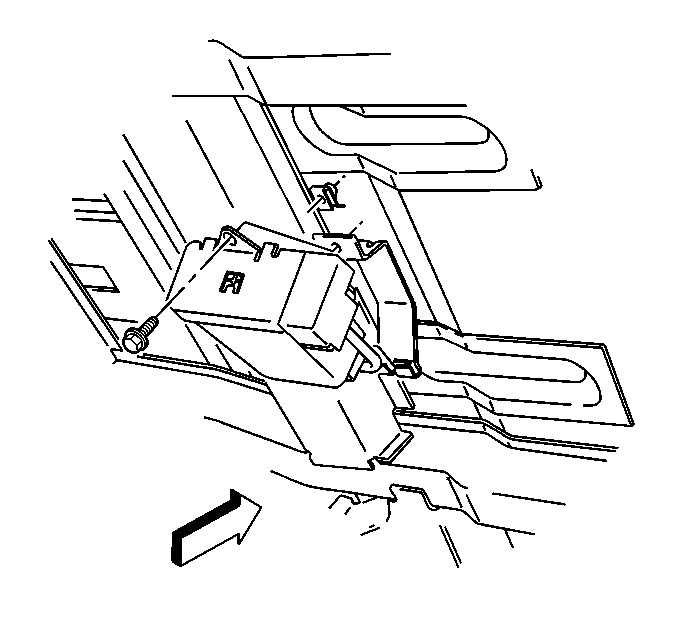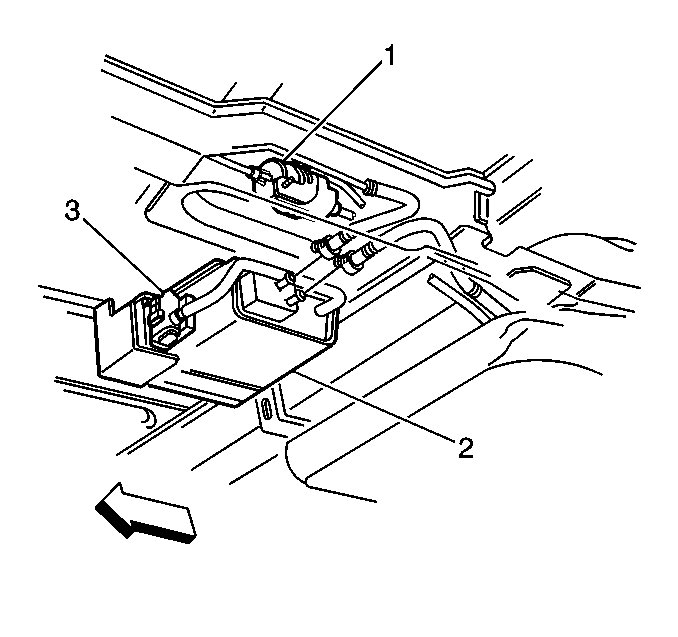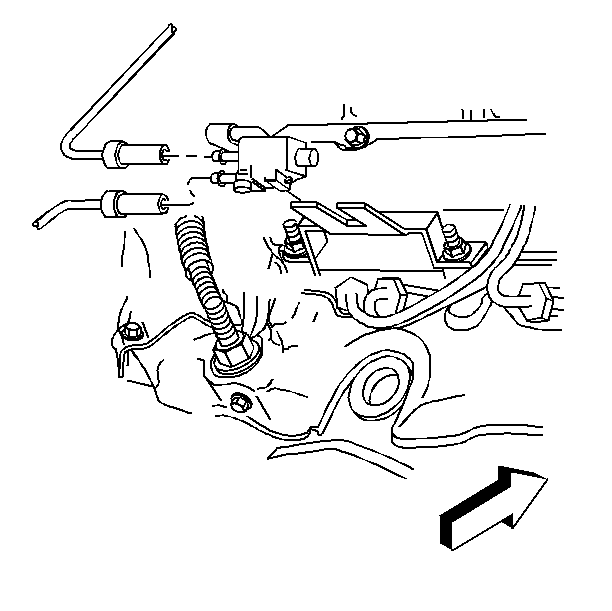
The basic Evaporative
Emission (EVAP) Control system used on all vehicles is the
charcoal canister
storage method. This method transfers fuel vapor
from the fuel tank to an activated carbon (charcoal) storage
device (canister) to hold the vapors when the vehicle is not operating.
When the engine is running, the fuel vapor is purged from the carbon
element by intake air flow and consumed in the normal combustion
process.
Enhanced EVAP System Operation

The EVAP purge solenoid
valve allows manifold vacuum to purge the canister. The Powertrain Control
Module (PCM) supplies a ground to energize the EVAP purge solenoid
valve (purge ON). The EVAP purge solenoid control is Pulse Width Modulated
(PWM) or turned ON and OFF several times a second. The PCM controlled
PWM output is commanded when the appropriate conditions have been
met:
| • | Engine coolant temperature above 25°C (77°F). |
| • | After the engine has been running about 2 1/2 minutes
on a cold start or 30 seconds on a warm start. |
| • | The vehicle is operating in closed loop fuel control. |
Canister purge PWM duty cycle varies according to operating conditions
determined by mass air flow, fuel trim, and intake air temperature. Canister
purge will be disabled if TP angle increases to above 70%. Canister purge
will be re enabled when TP angle decreases below 66%.
The evaporative leak detection diagnostic strategy is based on applying
vacuum to the EVAP system and monitoring vacuum decay.
The fuel level sensor input to the PCM is used to determine if the
fuel level in the tank is correct to run the EVAP diagnostic tests.
To ensure sufficient volume in the tank to begin the various diagnostic
tests, the
fuel level must be between 15% and 85%.
The PCM monitors system vacuum level via the fuel tank pressure sensor
input.
OBD II Evaporative Emission System - Fuel Tank Vacuum Sensing
General Description (Enhanced EVAP)
The evaporative system includes the following components:
| • | Evaporative emission canister vent solenoid |
| • | Fuel tank pressure sensor |
| • | Evaporative emission canister |
Results of Incorrect Operation
Poor idle, stalling and poor driveability can be caused by:
| • | Malfunctioning purge solenoid. |
| • | Hoses/lines split, cracked and/or not connected properly. |
EVAP Purge Solenoid, EVAP Vent Solenoid and Fuel Tank Pressure Sensor

The evaporative leak
detection diagnostic strategy is based on applying vacuum to the EVAP system
and
monitoring vacuum decay.
Before the EVAP system diagnostic tests are run the following conditions
must be present:
| • | No TP sensor, ODM, IAT sensor, or MAP sensor DTCs set. |
| • | Engine coolant temperature is between 4°C and 30°C (40°F
and 86°F). |
| • | Start up engine coolant temperature is not more than 8°C
(14°F) greater than start up intake air temperature. |
| • | Intake air temperature is between 4°C and 30°C (40°F
and 86°F). |
| • | Start up intake air temperature is not more than 2°C (4°F)
greater than start up engine coolant temperature. |
| • | Fuel tank level is between 15% and 85% |
The EVAP system diagnostic tests will be run following a cold start,
as indicated by the ECT and IAT sensors. The fuel level sensor
input to the PCM is used to determine if the fuel level in the tank is
correct to run the EVAP diagnostic tests. To ensure sufficient
volume in the tank to begin the various diagnostic tests, the
fuel level must be between 15% and 85%.
The PCM monitors vacuum level via the fuel tank pressure sensor input.
At an appropriate time, the EVAP purge solenoid and the EVAP vent
solenoid are turned ON, allowing engine vacuum to draw a small vacuum on
the entire evaporative emission system. After the desired vacuum
level has been achieved, the EVAP purge solenoid is turned OFF,
sealing the system. A leak is detected by monitoring for a decrease
in vacuum level over a given time period, all
other variables remaining
constant. A small leak in the system will cause
DTC P0442
to be set.
If the desired vacuum level cannot be achieved in the test described
above, a large leak or a faulty EVAP purge solenoid is indicated.
This can be caused by the following conditions:
| • | Disconnected or faulty fuel tank pressure sensor. |
| • | Missing or faulty fuel cap. |
| • | Disconnected, damaged, pinched, or blocked EVAP purge line. |
| • | Disconnected or damaged EVAP vent hose. |
| • | Disconnected, damaged, pinched, or blocked fuel tank vapor line. |
| • | Disconnected or faulty EVAP canister solenoid. |
| • | Disconnected or faulty EVAP vent solenoid. |
| • | Open ignition feed circuit to the EVAP vent or purge solenoid. |
Any of the above conditions can set DTC P0440.
A restricted or blocked EVAP canister vent path is detected by drawing
vacuum into the EVAP system, turning OFF the EVAP vent solenoid
and the EVAP purge solenoid (EVAP vent solenoid Open, EVAP purge PWM 0%)
and monitoring the fuel tank pressure sensor input. With the EVAP
vent solenoid open, any vacuum in the system should decrease quickly
unless the vent path is blocked. A blockage can be caused by the
following conditions:
| • | Faulty EVAP vent solenoid (stuck closed). |
| • | Plugged kinked or pinched vent hose. |
| • | Shorted EVAP vent solenoid driver circuit. |
| • | Plugged evaporative canister. |
If any of these conditions are present, DTC P0446 will set.
The system checks for conditions that cause the EVAP system to purge
continuously by commanding the EVAP vent solenoid ON and the
EVAP purge solenoid OFF (EVAP vent solenoid CLOSED, EVAP purge
PWM 0 %). If fuel tank
pressure level increases during the
test, a continuous purge flow condition
is indicated. This can be
caused by the following conditions:
| • | EVAP purge solenoid leaking. |
| • | EVAP purge and engine vacuum source lines switched at the EVAP
purge solenoid. |
| • | EVAP purge solenoid driver circuit grounded. |
If any of these conditions are present, DTC P1441 will set.
Refer to the DTC charts for further diagnostic procedures regarding
the EVAP system.



